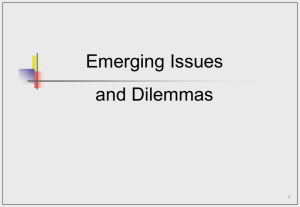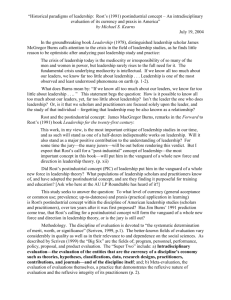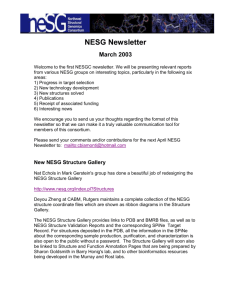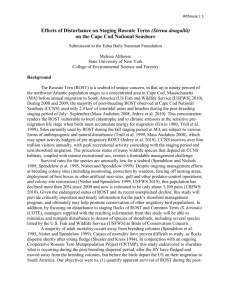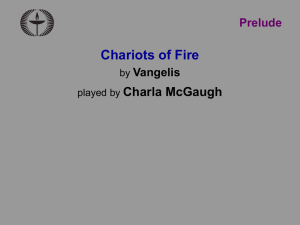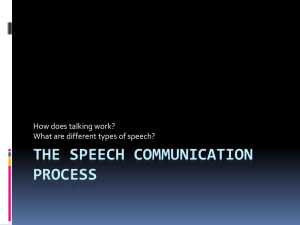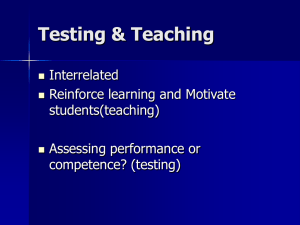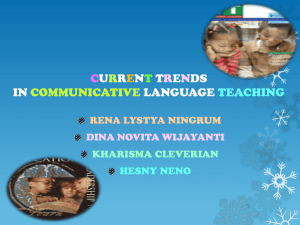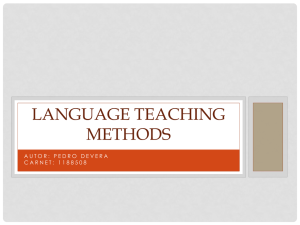DONGBEI UNIVERISTY WORKSHOP Developing Communicative
advertisement
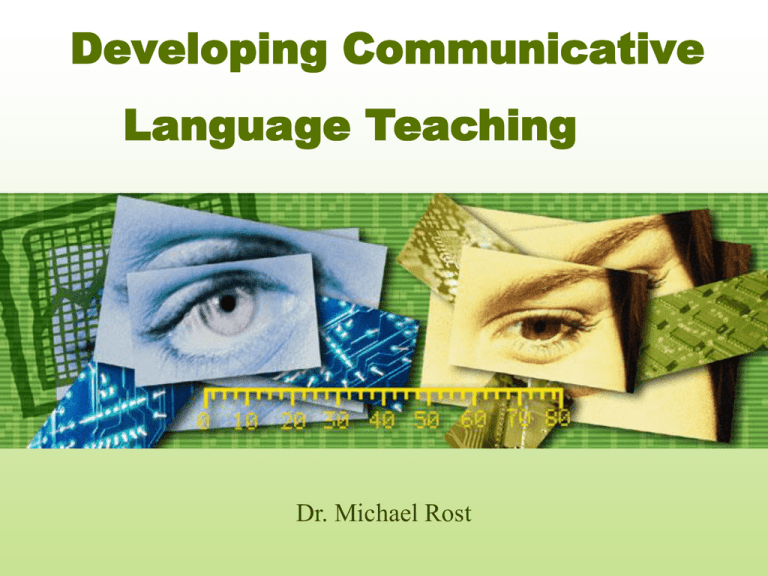
Developing Communicative Language Teaching Dr. Michael Rost Warm up: Mixer > Find a partner near you, talk for 1 minute – then when you hear the word “Change”, change partners: • What is something really important that happened in your life this year? • Why is it important to you? © Michael Rost What is an effective communicative activity? • • • • Engaged? (have to use strategies) Personal? (have to reveal something) Communication Gap? (need to listen) Task? (outcome that is verifiable) © Michael Rost One key : articulating standards for …what is successful communication (in L1 and L2) © Michael Rost …how students can achieve this success step by step 3 types of communicative assessment: Holistic © Michael Rost Checklist Scale Example of holistic evaluation • How did you like this activity? [1] ………[2] ……… [3] ………[4] ………[5] Boring Interesting Not Worthwhile Valuable • If we do this activity again, what might we do differently? © Michael Rost The advantages of holistic evaluation • natural and spontaneous • open to interpretation by everyone • gives personal insights © Michael Rost Let’s retry an activity… with communicative goals in mind … This time, let’s focus on… What adds value to this activity? • Speaker “readiness”, knowledge of topic • Personalization – opportunity, willingness, and desire to show one’s personal side • Supportive listener – an interested partner who wants to learn something © Michael Rost Activity: Pair Exchange Who has been the best teacher in your life so far? What makes this person the best teacher for you? © Michael Rost Conditions • Think for one minute before you start. • Take turns. 2 minutes for each person only. Face each other. Speaker: Describe the person carefully. Tell about one time that he or she was a good teacher. Listener: Listener: Listen quietly for one minute. Then ask at least 3 questions to learn more about the person’s teacher. Try to summarize what makes this person a great teacher. Speakers & Listeners: Aim to use English 90% of the time! © Michael Rost Example of check list evaluation Did you … __ speak for 1 minute in English only? __ make your ideas clear to your partner? __ ask at least 3 questions? __ learn any new vocabulary in this activity? © Michael Rost This type of assessment is a “checklist” type. Notice: We focus on a few performance variables. If our students meet these performance criteria, they have done the task well. © Michael Rost If our students have troubles with any of the criteria, • We need to help them focus on the criteria. And • …give more support • … let them try again! © Michael Rost The advantages of checklists: • clear and fair to everyone • provides more specific feedback • easy to adjust & expand © Michael Rost Assessment checklists are used for “achievement tests”: • They measure whether our students have achieved the specific objectives of the unit. © Michael Rost 3rd kind of assessment: Scale-based Communicative Scales are based on: • dynamic, interactive criteria • possibility of corrective feedback © Michael Rost Examples of feedback: • good intention • sensitive • performed the task well • clear and logical • used effective connectors (especially _________ ) • used appropriate vocabulary (especially _______ ) • used appropriate grammar (especially ________ ) © Michael Rost Examples of feedback, TYPE 1 • clear pronunciation • animated intonation • correct grammatical structures • range of structures • precise vocabulary choice • formulaic language © Michael Rost Examples of feedback, TYPE 2 • smoothness • richness of content • confidence • “communicative image” • interactivity – listening to partner • intention to communicate © Michael Rost Activity: Speaking Circle Speaker’s Topic: • Talk for 1 minute: • Who influenced you more – your father or your mother? How did he or she influence you? Listeners’ Task: • Listen quietly for 1 minute • Then ask for specific examples • At the end, give feedback on speaker’s main point. © Michael Rost Activity: Spotlight Speaker’s Topic: Listener’s Task: List 5 important dates. Why are they important? Answer your partner’s questions. Choose a date. Ask why it’s important. Ask 3 “follow on” questions. Monitor’s Task: Pay attention to the accuracy and fluency of both S & L. Give positive feedback at the end. © Michael Rost A note about “mistakes” • role of mistakes and recasts in SLA • role of “attitude about mistakes” in development © Michael Rost Converting feedback to a communicative scale assessment Most widely used scales: • TSE (TOEFL, Test of Spoken English) • ILR • FSI • ELIUM • ORDINATE • COE (Council of Europe) © Michael Rost Key concepts: • “Base Line” or “Native speaker” norms • “Rule-space” analysis of skills • Continuum of performance variables: not skills, but interactive processes © Michael Rost COMMON TERMS USED IN COMMUNICATIVE RATING SCALES • Effectiveness of communication: The degree to which an intended message is communicated successfully and efficiently conveyed to a listener. • Task Completion: The performance of an appropriate language function in a specified context. • Communication strategies: Communication techniques such as paraphrase, examples, redundancy, or demonstration to make one’s communication more effective or to compensate for language deficiencies. • Coherence: The clear and logical organization of the speaker’s utterances. • Response to partner: The sensitivity of the speaker to the listener and the social situation. • Accuracy: The degree to which pronunciation, grammar, fluency, and vocabulary approach that of a native speaker. • Fluency: Smoothly flowing speech. • Vocabulary: Words and expressions that are appropriate for the intended message. © Michael Rost Some Important Scale Descriptors (= Values!) • • • • • • • • • volunteers information freely goes beyond the minimum task repairs own mistakes gives strong ideas maintains strong contact with audience has a clear purpose smooth delivery range of vocabulary range of grammar structures © Michael Rost A band scale for holistic assessment © Michael Rost Framework for a communication assessment scale Fluency Accuracy Complexity Interactivity 4 3 2 1 5 © Michael Rost A framework for holistic assessment Fluency Accuracy Complexity Interactivity 4 3 2 1 5 © Michael Rost Conclusion: 1. You can make your own assessment tools: Holistic © Michael Rost Checklist Scale Conclusion: 2. You can use assessment tools: • to promote awareness • to allow students to learn from feedback • to describe each student’s progress toward communicative goals © Michael Rost Summary: • Assessment is vital for student progress in communication. • Assessment can be flexible – it can and should take many forms. • Evaluation should always include self-assessment. • Communicative goals must be described to students. • Effective communication should be modeled for students. • Feedback is the key to progress – give every student feedback in every class © Michael Rost Thank you for your participation! You can download this presentation (Developing Communicative Language Teaching) from my blog: latcomm.com/seminars/downloads © Michael Rost
